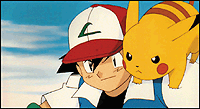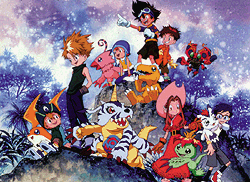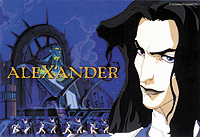With the success of such features as Pokemon, are beleaguered U.S. majors going to look for more Japanese imports? Fred Patten explains the pros and cons by giving a glimpse inside the Japanese film scene.

Vampire Hunter D. © Hideyuki Kikuchi/Asahi Sonorama/Vampire Hunter D Production Committee.
On July 21, Japan's second annual (1999) Pokémon theatrical feature was released in America as Pokémon: The Movie 2000, placing number 3 in the weekend nationwide box office ratings. Coincidentally the third Pokémon feature, Pocket Monsters: Lord of the Unknown Tower, hit Japan's theaters on July 8 to also rank number 3 in that country's weekend ratings.
Japanese animation (anime) has exploded into the American consciousness over the past three or four years. There has been animation from Japan in America since the 1960s with movies like Alakazam the Great and TV programs like Astro Boy, but anime as a distinct cultural genre was not noticed until the 1990s. First came the anime video cult market ("Japanese animation isn't just for kids!") in the early 1990s, available only by mail order and through comic-book specialty bookshops. Then in the mid-'90s came a few adolescent and adult animated sci-fi and fantasy dramatic features like Akira and Vampire Hunter D on cable TV's Cartoon Network and Sci-Fi Channel, and young teen TV series like Sailor Moon and Dragon Ball Z, while anime videos began to appear in general video shops.
Then Pokémon hit America in 1998.

Pokemon. © Warner Bros. No other uses are permitted without the prior written consent of owner. Use of the material in violation of the foregoing may result in civil and/or criminal penalties.
By now most Americans -- most American parents whose children watch TV, at least -- know that while Pokémon may have originated as a Japanese video game, its most visible and popular incarnation is as a TV cartoon series. They have seen that the Pokémon TV series has spun off at least two Pokémon theatrical features. The TV industry's dash to cash in on the Pokémon mania has resulted in the importation of such similar Japanese TV cartoons as Digimon, Monster Rancher and Cardcaptors. And there are apparently theatrical features of these as well. Digimon: The Movie hits America's theaters on October 6. Meanwhile, the kids are bringing home new videos of at least three Sailor Moon movies that were theatrical releases in Japan if not here.
A New Question
How popular is theatrical animation in Japan? Can those movies also be popular in America? This is no idle question, especially considering the results of this summer's American theatrical animation releases. Only Chicken Run -- a British production, but strongly supported by its American distributor, DreamWorks -- has been really successful. Most American theatrical animated features so far this year have not earned back their production costs. Pokémon: The Movie 2000, released July 21 as I mentioned, had grosses of over $40,700,000 as of August 13, while 20th Century Fox's Titan A.E., released over a month earlier, only had grosses of $22,640,000 by that same weekend (statistics from the Internet Movie Database). Will it be more practical for the American movie industry to start importing Japanese animated features in a big way, at much lower production costs for just dubbing and minor editing, than to continue to support the productions of completely new American animated features?
It is true that there are many more theatrical animated productions in Japan than in America. A few of them certainly warrant serious consideration for the American theatrical market. But on the whole, Japanese productions are not easily transferable to American theatergoers' tastes.
An average of three or four animated theatrical releases appear in Japan every month. These fall into three main categories: 1. Movies based on popular TV/young children's cartoon series. 2. Original dramatic features for older audiences, usually based upon comic books and sci-fi novels. 3. Foreign imports.

Sailor Moon. © DIC Entertainment. All Rights Reserved.
TV animation for children is extremely popular in Japan, even more so than in America. There is also a much greater prevalence of a popular TV cartoon series spinning off a theatrical feature. This is how the Pokémon, Sailor Moon and Dragon Ball Z theatrical features came to be made. However movies of this nature are like the Star Trek theatrical features: they are really designed for the fans of the TV series. Movies of this nature will not have much box-office potential until their TV series are established on American TV. For example, the Japanese TV series Card Captor Sakura just began as Cardcaptors in June on the Kids' WB! network in the U.S. and Teletoon in Canada. This may make the Card Captor Sakura: The Movie feature (August 1999 in Japan) viable as an American theatrical release, if the TV series develops sufficient popularity. Another Japanese TV cartoon series with a theatrical feature in reserve, Meitantei Conan (Conan, the Great Detective, about a boy super-detective), is reportedly in development for the Fox Kids Network.
The Differences But not all Japanese TV cartoon series have potential for American release. Two notably frustrating examples are Doraemon and Sore Ike! Anpanman, both for young children. Doraemon is about a blue robot cat, a toy from hundreds of years in the future, which is sent via time travel to a comically clumsy 20th century schoolboy. Doraemon began on TV in April 1979; the TV series is up to almost 1,600 episodes to date. There has been a mid-March annual Doraemon theatrical feature since 1980. The American movie/TV industry would love to cash in on these. But many of the stories about Doraemon the robot-cat and his human owner/playmate, Nobita, are gentle teaching experiences framed around Japanese ethnic customs (including communal bathing), Japanese holidays, Japanese folk tales and Japanese historical events, which young American children would not understand. Sore Ike! Anpanman (roughly Go Get 'Em, Anpanman!) is a superhero comedy for young children in which most of the characters are Japanese toys, fairytale characters and anthropomorphized candies and sweets. (Anpan is a sweet pastry.) The weekly TV series began in October 1988; episode #576 aired on August 4, 2000. The annual theatrical features started in 1995; this year's, released on July 29, was Sore Ike! Anpanman: Ningyo Hime no Namida (Go Get 'Em, Anpanman! Tears of the Mermaid Princess). These and others such as Crayon Shin-chan add up to a large quantity of Japanese theatrical animated features that would have little American audience appeal.

Digimon. © 2000 Fox Kids. All Rights Reserved.
There is a similar subclass of children's theatrical features which are blatantly Japanese corporate promotion. Two examples both released in July are the 2000 Nen Natsu Toei Anime Fair (Summer 2000 Toei Animation Fair) and the 2000 Nen Natsu no Kadokawa Manga Taiko Susumeru (Summer 2000 Kadokawa Cartoon Masterpiece Presentation). Toei Animation Co., Ltd. is the largest animation studio in Japan, and one of the largest in the world; both Dragon Ball Z and Sailor Moon are Toei productions. Kadokawa is a major Japanese publishing company; its children's book division is comparable to Scholastic Inc. or Golden Press in America. Movies of this type are 80- to 90-minute compilations of from two to four new featurettes of the company's currently most popular TV cartoons -- in Toei's case, its own studio's productions; in Kadokawa's case, licensed TV cartoons based upon its juvenile literary properties. These movies give Japanese children the chance to see their favorite TV cartoon characters in adventures of higher animation quality than the TV series. Often these featurettes are closely tied to the current TV story lines, introducing new characters and subplots to the TV series. The Digimon theatrical feature just released in America is actually edited from three Digimon featurettes in Toei's Spring and Summer Animation Fairs of the past couple of years. These are popular in Japan; The Summer 2000 Toei Animation Fair ranked number 7 overall among its week's theatrical releases in Japan. But for obvious reasons, they would be meaningless to children outside of Japan.
Another Demographic
More suitable for American importation are the theatrical features for adolescents and adults. Best-known in America are the features created by master animators Hayao Miyazaki and Isao Takahata, based upon their original stories through their Studio Ghibli since the mid-1980s; but these are a special case. Movies of this type are usually romances and dramas based upon popular novels, comic books, TV programs for older viewers, especially popular direct-to-video productions, and video games. Akira and Ghost in the Shell, adapted from adult sci-fi novels in comic-art form, are two well-known examples of Japanese popular movies that had limited art-house theatrical releases in America before going to video.

Akira. © Akira Committee.
Jin Roh (The Wolf Men), a taut political thriller about the plotting at high governmental levels for jurisdictional control of a new paramilitary police unit, was designed for the art-theater circuit in the first place. It played at international film festivals in Germany, Canada, the U.S. and other nations for a couple of years before its general release in Japan this February. A similar example is Alexander, an American-Japanese-Korean co-production of a fantasy based upon the 3rd-century B.C. Macedonian king who conquered most of Western civilization, elevating him to mythic stature similar to the demigod Hercules. This production, with character design by American animator Peter Chung (Aeon Flux), has also played at international film festivals. It will be released theatrically in Japan as Alexander Senki (roughly The Military Exploits of Alexander) in October. In 1985 Vampire Hunter D, a low-budget direct-to-video feature based upon the fantasy thriller novels by Hideyuki Kikuchi, proved unexpectedly popular, but dissatisfaction by Kikuchi over changes in his story held up any movie sequels. The movie has also proven popular as an American anime release since 1992 in art theaters and on video and cable TV. The legal problems in Japan were recently resolved, and a new, high-budget remake of Vampire Hunter D is just finishing production, by one of Japan's top anime directors, Yoshiaki Kawajiri, and with lots of CGI enhancement. Any of these would seem to be potential American theatrical releases of at least as much commercial validity as Miramax's release of Princess Mononoke.

Alexander Senki, a U.S.-Japanese-Korean joint anime-styled production. © Alexander Committee.
There are many Japanese popular teen romantic fantasies, roughly comparable to I Dream of Jeannie or Sabrina, the Teenage Witch. These usually begin as comic books and graduate to animated TV cartoon series or direct-to-video productions. (The Japanese created their own English abbreviation for these, OAVs for Original Anime Videos, which the American anime market has adapted.) Especially popular titles spin off theatrical sequels. A current example is Oh! My Goddess: Eternal Ties, in which the ongoing romance between a shy college student and a virginal young goddess is finally resolved -- or is it? Japanese theatrical audiences will find out this autumn. Oh! My Goddess is popular among American anime and comics fans through translations of the comic book soap-opera romances by Kosuke Fujishima and the OAVs. But would this popularity extend to a theatrical release of a sequel for a general American audience that is not already familiar with the relationships among its cast? This is why the many Japanese theatrical features of this nature have gone directly into the same anime video market as the TV episodes and the OAVs.
This also may change with the growth in popularity of anime for older viewers in America. The Japanese animation industry is eager to sell more of its product to America. Take for example the 1996 teen girls' romance TV series The Vision of Escaflowne, a 26-episode serial about a high school girl who is transported to a fantasy world. Escaflowne's continuing popularity with teens in both Japan and the U.S. through video sales has resulted this year in both an American TV release (Fox Kids Network, premiering in August) and a Japanese theatrical feature, Escaflowne: A Girl in Gaea (June release). This movie was also rushed to America for a preview at the Anime Expo 2000 fan convention (10,000 attendance) in Anaheim, California over the July 4th weekend, to help build a popular demand for an American theatrical rather than direct-to-video release. The above-mentioned new Vampire Hunter D feature in production was also promoted at Anime Expo 2000 with a theatrical trailer.

Check out an ultra-cool clip from Vampire Hunter D 2000. © Hideyuki Kikuchi/Asahi Sonorama/Vampire Hunter D Production Committee.
Another evolutionary development is the increase in international co-productions. The U.S.-Japanese-Korean Alexander is designed to be shown as either a TV series or theatrical feature. Its current theatrical release in Japan may help with its sale in America. A Final Fantasy theatrical feature, loosely based upon the Japanese video game series, is currently being publicized in both nations as an expected Japanese summer 2001 theatrical hit. This CGI science-fiction drama is being promoted heavily over the Internet with downloadable trailers and graphics, to excite America's action-adventure movie fans. Final Fantasy is a Japanese production being filmed at a studio located in Honolulu, with dialogue being recorded in Los Angeles for release in both countries. This could be the movie that will take Japanese theatrical animation from the art-theater circuit into American general theatrical releases.
If you are having trouble watching the Vampire Hunter D 2000 clip download the latest version of QuickTime now.
For more articles on Japan and anime, go to Animation World Magazine's archives and type in these keywords: Japan; anime.
Fred Patten has written on anime for fan and professional magazines since the late 1970s.







